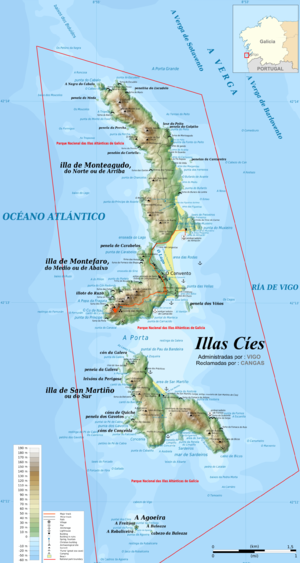Cíes Islands
| Native name: Illas Cíes | |
|---|---|

Location and topographic map of the Cíes Islands
|
|
| Geography | |
| Coordinates | 42°13′24″N 8°54′14″W / 42.223333°N 8.903889°W |
| Total islands | 3 |
| Major islands | Monteagudo, Do Faro, San Martiño |
| Highest elevation | 197 m (646 ft) |
| Administration | |
|
Spain
|
|
| Autonomous Community | Galicia |
| Province | Pontevedra |
| Municipality | Vigo |
| Demographics | |
| Population | 3 |
The Cíes Islands are an archipelago off the coast of Pontevedra in Galicia (Spain), in the mouth of the Ria de Vigo. They belong to the parish of San Francisco de Afora, in the municipality of Vigo. They were declared a Nature Reserve in 1980 and are included in the Atlantic Islands of Galicia National Park (Parque Nacional Marítimo-Terrestre das Illas Atlánticas de Galicia) created in 2002.
The Cíes consist of three islands, Monteagudo ("Sharp Mount" or North Island), do Faro ("Lighthouse Island", or Isla do Medio, "Middle Island") and San Martiño ("Saint Martin" or South Island).
Monteagudo is separated from the Morrazo peninsula by the North Canal while San Martiño is separated from the coast of Santoulo cape (mount Ferro) by the Freu da Porta Strait. The Do Faro island is linked to the North island by an accumulation of sand 1,200 m (3,937 ft) long known as Rodas beach, in the eastern side of the island. During high tide the sea flows between the islands in the western side and, blocked by the beach it fills the lagoon between the sandy area and the rocks. The highest peak is the Alto das Cíes (197 m (646 ft)) in Monteagudo.
The islands formed by the end of the Tertiary, when some parts of the coast sank, creating the rías ("estuaries"). All three islands are the peaks of the coastal mountains now partially under the sea and are formed mainly of granitic rock.
The land is mountainous with rough, nearly vertical cliffs of more than 100 m (328 ft) on the western side, and numerous caves (furnas) formed by erosion from the sea and the wind. The eastern side is less steep, covered by woods and bushes and protected from the Atlantic winds, allowing the formation of beaches and dunes.
...
Wikipedia
